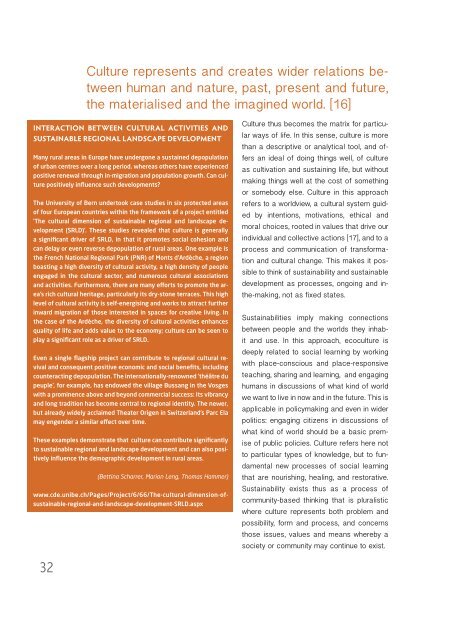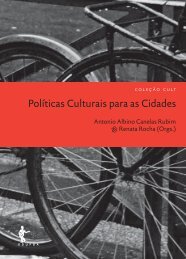Culture in for and as Sustainable Development
YIGflg
YIGflg
Create successful ePaper yourself
Turn your PDF publications into a flip-book with our unique Google optimized e-Paper software.
<strong>Culture</strong> represents <strong>and</strong> creates wider relations between<br />
human <strong>and</strong> nature, p<strong>as</strong>t, present <strong>and</strong> future,<br />
the materialised <strong>and</strong> the imag<strong>in</strong>ed world. [16]<br />
INTERACTION BETWEEN CULTURAL ACTIVITIES AND<br />
SUSTAINABLE REGIONAL LANDSCAPE DEVELOPMENT<br />
Many rural are<strong>as</strong> <strong>in</strong> Europe have undergone a susta<strong>in</strong>ed depopulation<br />
of urban centres over a long period, where<strong>as</strong> others have experienced<br />
positive renewal through <strong>in</strong>-migration <strong>and</strong> population growth. Can culture<br />
positively <strong>in</strong>fluence such developments?<br />
The University of Bern undertook c<strong>as</strong>e studies <strong>in</strong> six protected are<strong>as</strong><br />
of four European countries with<strong>in</strong> the framework of a project entitled<br />
‘The cultural dimension of susta<strong>in</strong>able regional <strong>and</strong> l<strong>and</strong>scape development<br />
(SRLD)’. These studies revealed that culture is generally<br />
a significant driver of SRLD, <strong>in</strong> that it promotes social cohesion <strong>and</strong><br />
can delay or even reverse depopulation of rural are<strong>as</strong>. One example is<br />
the French National Regional Park (PNR) of Monts d’Ardèche, a region<br />
bo<strong>as</strong>t<strong>in</strong>g a high diversity of cultural activity, a high density of people<br />
engaged <strong>in</strong> the cultural sector, <strong>and</strong> numerous cultural <strong>as</strong>sociations<br />
<strong>and</strong> activities. Furthermore, there are many ef<strong>for</strong>ts to promote the area’s<br />
rich cultural heritage, particularly its dry-stone terraces. This high<br />
level of cultural activity is self-energis<strong>in</strong>g <strong>and</strong> works to attract further<br />
<strong>in</strong>ward migration of those <strong>in</strong>terested <strong>in</strong> spaces <strong>for</strong> creative liv<strong>in</strong>g. In<br />
the c<strong>as</strong>e of the Ardèche, the diversity of cultural activities enhances<br />
quality of life <strong>and</strong> adds value to the economy; culture can be seen to<br />
play a significant role <strong>as</strong> a driver of SRLD.<br />
Even a s<strong>in</strong>gle flagship project can contribute to regional cultural revival<br />
<strong>and</strong> consequent positive economic <strong>and</strong> social benefits, <strong>in</strong>clud<strong>in</strong>g<br />
counteract<strong>in</strong>g depopulation. The <strong>in</strong>ternationally-renowned ‘théâtre du<br />
peuple’, <strong>for</strong> example, h<strong>as</strong> endowed the village Bussang <strong>in</strong> the Vosges<br />
with a prom<strong>in</strong>ence above <strong>and</strong> beyond commercial success: its vibrancy<br />
<strong>and</strong> long tradition h<strong>as</strong> become central to regional identity. The newer,<br />
but already widely acclaimed Theater Origen <strong>in</strong> Switzerl<strong>and</strong>’s Parc Ela<br />
may engender a similar effect over time.<br />
These examples demonstrate that culture can contribute significantly<br />
to susta<strong>in</strong>able regional <strong>and</strong> l<strong>and</strong>scape development <strong>and</strong> can also positively<br />
<strong>in</strong>fluence the demographic development <strong>in</strong> rural are<strong>as</strong>.<br />
(Bett<strong>in</strong>a Scharrer, Marion Leng, Thom<strong>as</strong> Hammer)<br />
www.cde.unibe.ch/Pages/Project/6/66/The-cultural-dimension-ofsusta<strong>in</strong>able-regional-<strong>and</strong>-l<strong>and</strong>scape-development-SRLD.<strong>as</strong>px<br />
<strong>Culture</strong> thus becomes the matrix <strong>for</strong> particular<br />
ways of life. In this sense, culture is more<br />
than a descriptive or analytical tool, <strong>and</strong> offers<br />
an ideal of do<strong>in</strong>g th<strong>in</strong>gs well, of culture<br />
<strong>as</strong> cultivation <strong>and</strong> susta<strong>in</strong><strong>in</strong>g life, but without<br />
mak<strong>in</strong>g th<strong>in</strong>gs well at the cost of someth<strong>in</strong>g<br />
or somebody else. <strong>Culture</strong> <strong>in</strong> this approach<br />
refers to a worldview, a cultural system guided<br />
by <strong>in</strong>tentions, motivations, ethical <strong>and</strong><br />
moral choices, rooted <strong>in</strong> values that drive our<br />
<strong>in</strong>dividual <strong>and</strong> collective actions [17], <strong>and</strong> to a<br />
process <strong>and</strong> communication of trans<strong>for</strong>mation<br />
<strong>and</strong> cultural change. This makes it possible<br />
to th<strong>in</strong>k of susta<strong>in</strong>ability <strong>and</strong> susta<strong>in</strong>able<br />
development <strong>as</strong> processes, ongo<strong>in</strong>g <strong>and</strong> <strong>in</strong>the-mak<strong>in</strong>g,<br />
not <strong>as</strong> fixed states.<br />
Susta<strong>in</strong>abilities imply mak<strong>in</strong>g connections<br />
between people <strong>and</strong> the worlds they <strong>in</strong>habit<br />
<strong>and</strong> use. In this approach, ecoculture is<br />
deeply related to social learn<strong>in</strong>g by work<strong>in</strong>g<br />
with place-conscious <strong>and</strong> place-responsive<br />
teach<strong>in</strong>g, shar<strong>in</strong>g <strong>and</strong> learn<strong>in</strong>g, <strong>and</strong> engag<strong>in</strong>g<br />
humans <strong>in</strong> discussions of what k<strong>in</strong>d of world<br />
we want to live <strong>in</strong> now <strong>and</strong> <strong>in</strong> the future. This is<br />
applicable <strong>in</strong> policymak<strong>in</strong>g <strong>and</strong> even <strong>in</strong> wider<br />
politics: engag<strong>in</strong>g citizens <strong>in</strong> discussions of<br />
what k<strong>in</strong>d of world should be a b<strong>as</strong>ic premise<br />
of public policies. <strong>Culture</strong> refers here not<br />
to particular types of knowledge, but to fundamental<br />
new processes of social learn<strong>in</strong>g<br />
that are nourish<strong>in</strong>g, heal<strong>in</strong>g, <strong>and</strong> restorative.<br />
Susta<strong>in</strong>ability exists thus <strong>as</strong> a process of<br />
community-b<strong>as</strong>ed th<strong>in</strong>k<strong>in</strong>g that is pluralistic<br />
where culture represents both problem <strong>and</strong><br />
possibility, <strong>for</strong>m <strong>and</strong> process, <strong>and</strong> concerns<br />
those issues, values <strong>and</strong> means whereby a<br />
society or community may cont<strong>in</strong>ue to exist.<br />
32




